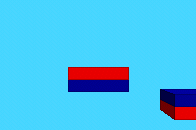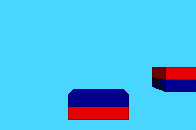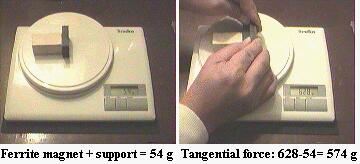

The Two Magnets Push-Pull Experiment
by Jean-Louis Naudin
created on 11-10-98 - JLN Labs - last update on 11-14-98
Now, I propose you a very simple experiment with two ferrite magnets, you need only to get :
1) Fix one of the ferrite magnet with a small adhesive (double faces) tape in the center of the plate balance with its north pole upward. Note the weight measured on a sheet of paper.
2) Take the other ferrite magnet with your hand with the north pole downward. Approach this magnet towards the top of the fixed magnet in order to generate a strong push downward due to the repulsion, and stop when the gap is about 1mm above. Note the maximum weight measured on the sheet of paper.


In the picture above the axial repulsive force measured is 1254 g.
Now, the next setp is to compare the repulsive force measured in the previous step, to the force acting on a translating magnet coming from the left to the right during its tangential approach above the fixed magnet. (see the animated picture below).

3) Unfix the magnet from the balance plate, and fix it with the adhesive tape, its south pole on the piece of wood so that the pole axis is horizontal.
4) Fix the apparatus with the adhesive tape on the balance plate, Note the weight measured on a sheet of paper.
5) Approach the other magnet in repulsive configuration, so that its tangential trajectory moves at 1 mm above the surface of the fixed magnet, as shown in the picture below. Note the maximum weight measured on a sheet of paper.

In the picture above the tangential repulsive force measured is 574 g.
You may notice that the tangential force is LESS THAN the axial repulsive force. This is confirmed by a computer simulation and calculation.
The maximum distance of the repulsive push is about 40 mm (on Fy) between the two magnets.
The repulsive force during the translation sequence begins at about 20 mm (on Fx) from the main magnetic axis.
So, its "seems" that the work generated seems "greater" than the work needed for producing the effect.....


Now, it is possible to think about some devices which use this principle, because the work generated by the "magnetic piston" is greater than the work needed to move the tangential "actuator magnet".

This seems a very simple way to use the magnetic energy from magnets for producing Free Energy....
You may see also : Some MPP's devices ideas...
If you need more informations or if you have any suggestions send me your Feedback
![]() Email
: JNaudin509@aol.com
Email
: JNaudin509@aol.com
Return to the Quantum Electrodynamics page